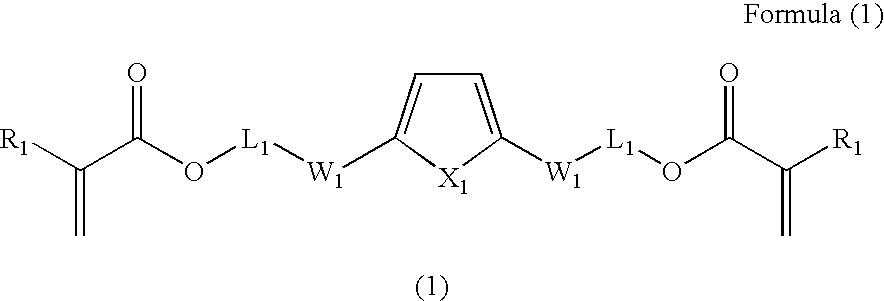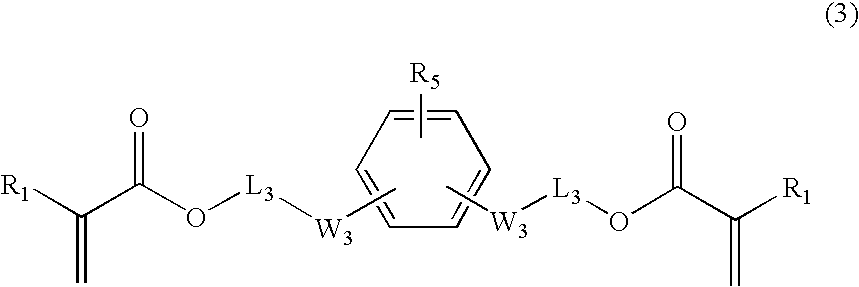High refractive index monomers, compositions and uses thereof
a technology monomers, applied in the field of new (meth) acrylic monomers, can solve the problems of increased optical dispersion, poor heat resistance, poor optical qualities of pc lenses, etc., and achieve the effect of high refractive index polymers
- Summary
- Abstract
- Description
- Claims
- Application Information
AI Technical Summary
Benefits of technology
Problems solved by technology
Method used
Image
Examples
example 1
[0122]
2,5-bis(Methacryloyloxyethylthiomethyl)thiophene
[0123]A stream of dry hydrochloric acid is bubbled vigorously through an aqueous solution of 37% formaldehyde (182 g; 2.24 moles) and concentrated HCl (147 ml) allowing the temperature to rise to 60° C. and the density to 1.18 g / cm3. The mixture is cooled to 30° C., whereupon thiophene (150 g; 1.79 moles) is added slowly with stirring and cooling to maintain the temperature between 25° C. and 30° C. After thiophene addition is complete, the mixture is stirred for an additional 20 min, the lower oily layer is separated, washed with cold water and distilled on a Vigreux column. The first fraction (46.4 g) is distilled at 30° C. and 1.2 mbar as a clear, colorless liquid, identified by GC and 1H NMR as pure 2-chloromethylthiophene; 1H NMR (CDCl3, δ ppm) 7.33 (d, 1H), 7.10 (d, 1H), 6.98 (dd, 1H), 4.83 (s, 2H). The second fraction (120.4 g; yield 60%) is distilled at 80° C. and 1.2 mbar as a clear, colorless liquid which solidifies upo...
example 2
[0126]
4,4′-Isopropylidinebis[(methacryloyloxyethylthio)benzene]
[0127]4,4′-Isopropylidinebis(thiophenol) is prepared by the Neumann-Kwart rearrangement of 4,4′-isopropylidinebis[(N,N-dimethylthiocarbamoyl)benzene] as described in J. Am. Chem. Soc. (1995), 117, 12416-12425 (24.2 g; yield 55% from bisphenol A). 4,4′-Isopropylidinebis-(thiophenol) (18.2 g; 0.07 moles) and NaOH 15% aqueous solution (40 g; 0.15 moles) are stirred for 1 h at 60° C. 2-Chloroethanol (12.1 g; 0.15 moles) is added dropwise and the reaction mixture is stirred at 60° C. for another 2 hours. The lower oily layer is separated, washed well with water and distilled at 230° C. and 0.4 mbar to give pure 4,4′-isopropylidinebis-(phenylthioethanol) (17 g; yield 70%; nD25 1.6102). 1H NMR (CDCl3, δ ppm) 7.32 (d, 4H), 7.16 (d, 4H), 3.76 (t, 4H), 3.11 (t, 4H), 2.28 (s, 2H), 1.67 (s, 6H).
[0128]Methacryloyl chloride (10 g of 97% purity; 93 mmoles) is added dropwise to a solution of 4,4′-isopropylidinebis(phenylthioethanol) (13...
example 3
[0129]
4,4′-Isopropylidinebis[(methacryloyloxyethylthioethyloxy)benzene]
[0130]4,4′-Isopropylidinebis(bromoethyloxybenzene) is prepared as described inJ. Am. Chem. Soc. (1988), 110, 6204-6210. A solution of 4,4′-isopropylidinebis(bromoethyloxybenzene) (100 g; 0.23 moles), 2-mercaptoethanol (36 g; 0.46 moles) and triethylamine (46.6 g; 0.46 moles) in acetonitrile is stirred for 24 h at room temperature. The solvent is removed under vacuum. The crude oil is dissolved in CH2Cl2, washed with aqueous 5% NaOH solution, dried over anhydrous Na2SO4, and stripped of solvent to give 4,4′-isopropylidinebis(hydroxyethylthioethyloxybenzene) as a pale-yellow, viscous liquid (98.7 g; yield 98%). 1H NMR (CDCl3, δ ppm) 7.14 (d, 4H), 6.80 (d, 4H), 4.14 (t, 4H), 3.79 (q, 4H), 2.92 (t, 4H), 2.84 (t, 4H), 2.4 (s, 2H), 1.64 (s, 6H). Methacryloyl chloride (10 g of 97% purity; 93 mmoles) is added dropwise to a solution of 4,4′-isopropylidinebis(hydroxyethylthioethyloxybenzene) (19.6 g; 45 mmoles) and triethy...
PUM
| Property | Measurement | Unit |
|---|---|---|
| RI | aaaaa | aaaaa |
| RI | aaaaa | aaaaa |
| transmittance | aaaaa | aaaaa |
Abstract
Description
Claims
Application Information
 Login to View More
Login to View More - R&D
- Intellectual Property
- Life Sciences
- Materials
- Tech Scout
- Unparalleled Data Quality
- Higher Quality Content
- 60% Fewer Hallucinations
Browse by: Latest US Patents, China's latest patents, Technical Efficacy Thesaurus, Application Domain, Technology Topic, Popular Technical Reports.
© 2025 PatSnap. All rights reserved.Legal|Privacy policy|Modern Slavery Act Transparency Statement|Sitemap|About US| Contact US: help@patsnap.com



